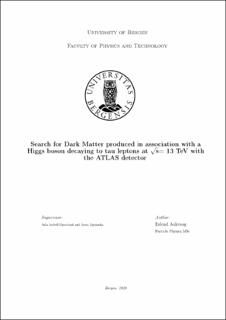Search for Dark Matter produced in association with a Higgs boson decaying to tau leptons at $\sqrt{\textrm{s}}$= 13 TeV with the ATLAS detector
Master thesis
Permanent lenke
https://hdl.handle.net/11250/2723789Utgivelsesdato
2020-12-09Metadata
Vis full innførselSamlinger
- Master theses [168]
Sammendrag
This thesis presents a search for Dark Matter produced in association with the Standard Model Higgs boson decaying into two tau leptons at $\sqrt{s}=13$ TeV using Run 2 data from the ATLAS detector corresponding to an integrated luminosity of 139 fb$^{-1}$. Specifically, the thesis documents a search for events predicted by the 2HDM+a, mono-Higgs signal model. The signature exploited here are two hadronically decaying taus with invariant mass consistent with the Standard Model Higgs boson and additional missing transverse energy. This model gives rise to two pseuodoscalar spin-0 bosons $a, A$, and by employing a specific set of benchmark parameters, scans in the $m_a-m_A$ signal grid has been performed in four signal regions. Two signal regions have been defined with a "cut and count" approach, and two with multivariate tools. Background contributions in the four signal regions have been estimated, and associated systematic uncertainties have been evaluated. Expected exclusion limits are set in the $m_a-m_A$ signal grid from exclusion fits performed on simulated Asimov data in the four signal regions. Signal points within the set contours are expected to be excluded at 95$\%$ confidence level. This result is complementary to other topology searches for the 2HDM+a model performed by ATLAS in the $m_A-m_a$ grid, \cite{Aaboud_2019}. These searches have employed the same set of benchmark parameters as in this analysis. The analysis has not yet been approved for unblinding by the ATLAS experiment, and the presented material would need be reviewed before looking at real data in the signal regions. Once unblinded however, the aim is to redo the exclusion limits on real data and statistically combine the result with the current ATLAS limits.
Beskrivelse
Revised version: some spelling errors corrected.
